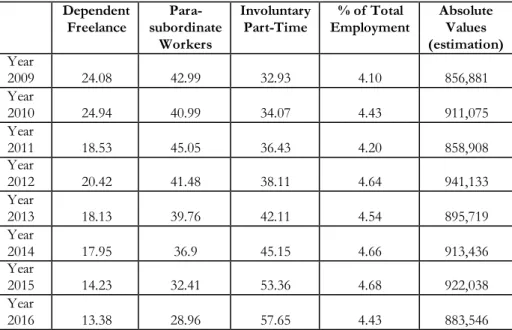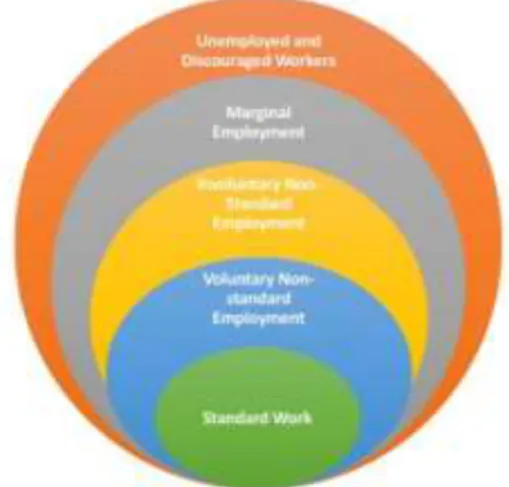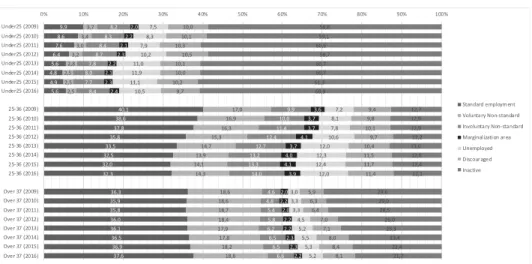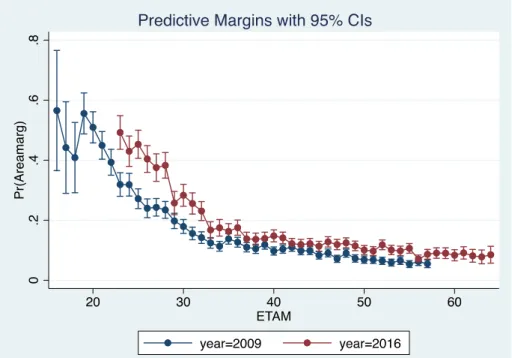Marginal workers are non-standard workers whose involuntary, intermittent and ambiguous character in the labor market prevents them from accessing social protection. Labor market segmentation theories have recently gained new momentum after the success of the book "The Age of Dualisation"1. They are non-standard workers whose involuntary, intermittent and undefined character in the labor market limits access to social protection schemes.
First, labor market reforms over the past 20 years have always followed the principle. The concept of marginal work comes from the previously mentioned theories on segmentation and dualization of the labor market. The contribution answers the following questions: what are the consequences of deregulation on the Italian labor market?
The fourth paragraph describes the data source and variable operationalization created to examine marginal work in the Italian labor market. Segmentation patterns in the UK labor market from the late 1990s to the post-crisis late 2000s.
The Nature of Italian Deregulation
He introduced several non-standard contractual arrangements (such as on-call, occasional work, etc.). The Fornero reform introduced a separate unemployment benefit for non-standard workers, less generous but with fewer requirements. So its influence remains ambiguous; it intervened to reduce inequality in social security for non-standard work40.
The latest reform introduced in Italy is the "Job Law" (the law addressed two issues left unresolved after the Biagi Law: contract simplification and social protection for non-standard work. NaSPI - new abbreviation for unemployment benefit - greater accessibility for all types of non-standard workers In these nine years, the socio-economic situation has changed due to the increase in non-standard contracts established by the Treu and Biagi laws.
However, unemployment benefits (unchanged) were inadequate to offer the same level of protection to all non-standard workers. The centrality of standard work is also determined by the fact that it is still the most widespread form of employment (§ § 5), despite the constant increase in the share of non-standard work in recent decades48. On the other hand, the other group of outsiders, the involuntary non-standard workers, suffer from this condition and its disadvantage.
Also, with a non-standard work contract and fewer claims to benefits compared to insiders, their marginalization is higher than voluntary non-standard workers because they did not choose this condition50. Marginal workers are those non-standard workers whose integration into the labor market is so fragile and variable that it allows them minimal access to social protection and unemployment benefits. The margin-center metaphor is a powerful tool for identifying those who are progressively leaking from social protection in a situation where they are significantly more vulnerable than the rest of the non-standard workers.
Therefore, as will be shown in the next section, marginal work is a phenomenon involving only specific types of non-standard workers.
Marginal Work Data Sources and Operationalisation 1 Marginal Work Operationalisation
Population and Data Sources
This article presents an analysis based on the Italian Labor Force Survey to assess trends in non-standard and marginal work in Italy in the eight years following the financial crisis. The population under analysis is between 15 and 64 years old and is further divided into three main age groups: young people - under 25 years; young adults - between 25 and 36 years; and adults - older than 37 years. These thresholds were chosen based on the literature and the timeframe of institutional reforms: 25 years is considered the lower limit of the "best age".
In other words, the age of 36 is a symbolic threshold, marking the first generation to spend their entire career in a deregulated labor market.64 Age is an under-researched dimension of labor market stratification, but it is highly relevant when it come to the The choice of 2009 as the lower bound stems from the availability of in-depth information in the Italian Labor Force Survey, which is released specifically for research purposes. The analysis excludes migrants from non-OECD countries due to their segregation in low-skilled and poor manual occupations66.
The empirical section will first present a descriptive analysis showing the distribution of the different types of work identified (standard, voluntary non-standard, involuntary non-standard and marginal work) and how they changed in the eight years . Finally, the analysis is completed by running a logistic regression to estimate the probability of being a marginal worker according to the year of birth and the year of the survey (2009 and 2016).
Empirical Evidence about Marginal Work
In the case of subordinates (34.9%) and dependent freelancers (41.1%), more than a third of employees have at least tertiary education (see Table A3 in the Annex). The different distribution of the types of marginal employment is also reflected in the occupational positions held by different workers. In 2016, involuntary part-time workers made up two-thirds of the total number of marginal workers, up from just one-third in 2009.
Given the downward trend of the Italian labor market after the financial crisis68, it can also be rightly argued that this progressive transition from dependent self-employed and para-subordinate work to involuntary part-time work is not only the result of the effect of labor reforms, but is also related to the reduction in demand for workforce for high-skilled jobs and advanced business services after years of crisis that have seen the number of para-subordinates and freelancers decline in recent years. For older workers, the eight years have been characterized by a slight increase in the rate of standard employment, to about 37% of the population. We can assume that these trends among older workers are the result of the pension reforms of the last decade, which aimed to increase the permanence of workers in the workforce (Laws 122/2010 and 148/2011, Sacconi Laws; Legislative Decree 201 /2011, Fornero Law).
In recent years, unemployment (+28.3%) and marginal work (+16.5%) have grown among this group, but the percentage of total employment that marginal work represents (2.4%) is still less than in the primary age group (3.9%). For this group, during the period there was a loss of approximately a quarter of the total standard employment, falling from 40.1% of the total population in 2009 to 32.2% in 2016. The results of this descriptive analysis are further confirmed by analyzing the effect of the year of birth on the probability of being marginally employed via logistic regression analysis.
Looking at Figure 4, the two rows for 2009 and 2016 show the movement toward marginal labor in 2016; however, the magnitude of the shift is not evenly distributed across age groups and is more pronounced for younger generations (the chart only considers generations of workers who were of working age in the two reference years, i.e. those born between 1953 and 1993). Although the sharp increase can be explained as an effect of the financial crisis, it is nevertheless clear that older workers were not affected by the crisis in the same way as younger ones and that deregulation led to a deterioration of labor market conditions, mainly by the young people. the workers. However, this interpretation does not fit the profile of Italian marginal workers with human capital to offer in the labor market and are still young enough to be more productive than the average adult worker.
It could be more realistic to argue that marginal work is a legacy of how deregulation has been implemented in Italy due to the disjunction between the social protection schemes and the changed economic conditions of workers, as predicted by the policy drift theory71.

Discussion and Conclusions
Work experience does not seem to be a possible explanation, as marginal work is also a significant phenomenon among the over 30s, not just the younger newcomers. Labor force survey this paper has shown that a significant part of non-standard workers went from standard employment in the eight years, a phenomenon that particularly affects the population of young adults (25-36 years). The role of institutions in creating multiple categories of outsiders was already proven by Jessoula et al., in 201076, by analyzing the categories of workers who stood between insiders and outsiders in the Italian system.
However, different from them and similar to Yoon and Chung (2016)77, our analysis showed how the process of implementing deregulation in Italy has also determined the progressive operation of specific categories of workers outside the social protection systems, with a clear generational division determined. by "deregulation at the margin". Our analysis does not derive from a subjective perception of the worker regarding their job security as in the cited research. Selective Flexicurity' in Segmented Labor Markets: The Case of Italian 'Mid-Siders.' Journal of Social Policy.
Although being an involuntary non-standard employed worker is also a subjective condition, much empirical evidence has shown that such a condition exposes a problematic integration into the social protection system, determined by the reduced number of working hours, which affects their society. contributions83. The problem of younger generations depends on their unequal exposure to deregulation, which is different between the generations coming after the first reforms compared to those already employed. Proponents of the insider/outsider divide thesis have encouraged the relaxation of anti-dismissal norms in standard employment relationships to favor the transition between insiders and outsiders.
In addition to the majority of Italian non-standard workers, the situation of marginal workers is involuntary: they accept this type of work because there are no jobs with good working conditions (full-time and dependent). If this policy seems unrealistic given the current economic outlook, at least expanding non-standard workers' access and rights to active labor market policies should empower them enough to find employment with better conditions. In short, this analysis confirms the consolidation of multiple segmentations in the labor market in Italy, in which the traditional divide between insiders and outsiders has resulted in greater fragmentation than a simple dualism and a situation of marginality, mostly concentrated among the younger generations.
In Myths of employment deregulation: How it neither creates jobs nor reduces labor market segmentation (p. 18).


